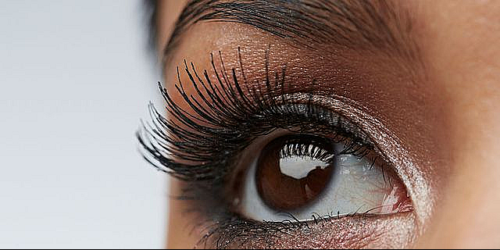The glue that is used to make the lashes adhere can cause allergy issues for some. In the past, many types of glues contained formaldehyde, a common contact allergen. The lashes themselves might also be a problem for women who are allergic to animal hair. There are typically three types of artificial lashes: synthetic lashes, human hair lashes, and mink fur lashes. Synthetic lashes are inexpensive and made from man-made materials, including rubber and other recyclable materials. Human hair lashes are the best ones you can find, and they accurately mimic the look of your own lash. Lastly, lashes made from mink are unsurprisingly the most expensive lash you can buy. They are often made by hand and are composed of fur from the tails of the mink. Some lashes are still made of horsehair. Horsehair lashes can be expensive as well, and due to their natural shape, they can also mimic the look of human hair eyelashes. The hairs are collected from a horse’s tail.
Both the glue adhesive and animal hair lashes can cause such bad reactions in lash users, such as eyelid swelling, itching, scaling, and infection of the cornea and eyelid. The products might even cause total loss of the natural eyelashes.
According to Maritza Perez, M.D., associate professor of clinical dermatology at the Mount Sinai Icahn School of Medicine in New York City, “Unfortunately, patients cannot protect themselves from these allergic reactions since it is genetically predetermined and no one can predict the allergy except for a previous manifestation or family history.” Oftentimes, allergic reactions to fake lashes might not occur the very first time they are applied. Allergies can suddenly develop at some point way down the line, no matter the age.
Dr. Perez warns that the more natural-looking individual fake lashes are also allergens and can cause yet another type of eye infection. “These types of lashes have a tendency to fall faster. Some patients will not clean the area thoroughly around the eyes in order to lengthen the duration of the lashes. This puts the patients at risk of infectious conjunctivitis or pink eye.”
Besides the allergies involved in wearing these beauty adornments, doctors warn that the weight of the lash extensions can severely damage natural lashes. As natural lashes get yanked out with the removal of the fakes, they become more and more sparse as time goes on. If this happens, eventually, you will want to constantly fill in your natural lash loss with the false ones.
Dry eye sufferers will want to think twice before joining the fake lash craze. Wearing longer lashes increases airflow around the eye and leads to more dust hitting the surface. This means the eyes are left unprotected and are more likely to dry out.
But wait, what about those magnetic lashes?
Magnetic lashes are the newest beauty looks on the block and are secured with tiny magnets. The lashes sandwich the existing natural lashes between two magnetic strips. Once they’re on, they are practically locked in place, thus eliminating the pain of taking them off later on. There is a general medical consensus that these lashes are safe, and there’s really no cause for concern in using magnets near the eyes. The lashes are even more preferable because of the absence of glue, which can contain harmful ingredients. One thing, though, you’ll have to take the lashes off if you’re going into magnet sensitive machines, like MRIs.
Lash extensions and glue are not currently regulated by the U.S. Food and Drug Administration. And although rare, extensions can also lead to fibers getting stuck under the eye tissue, which may require surgical removal.
If you still feel fake lashes are worth all the health risks, consider these safety measures from the American Academy of Ophthalmology:
- Does the salon have a good reputation? How long have they been in business, and do they practice good hygiene? Read reviews and look at before-and-after photos from other customers.
- Ensure that the aesthetician is trained/certified and working at a reputable establishment.
- Check that the aesthetician practices adequate handwashing and proper hygiene.
- Check the eyelash adhesive ingredients before using. Confirm the expiration date has not passed. Request a spot test on the inside of your wrist before the glue is applied to your eyes.
If you develop an infection, irritation, or allergic reaction to the application of the lash extensions, make an appointment to see an ophthalmologist as soon as possible.











